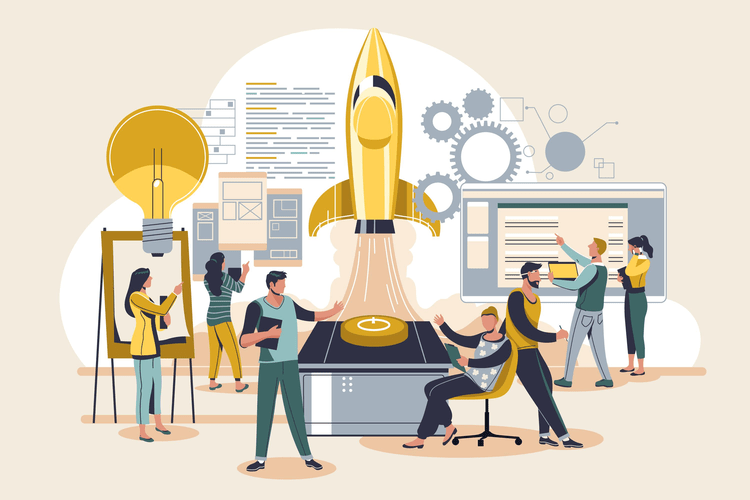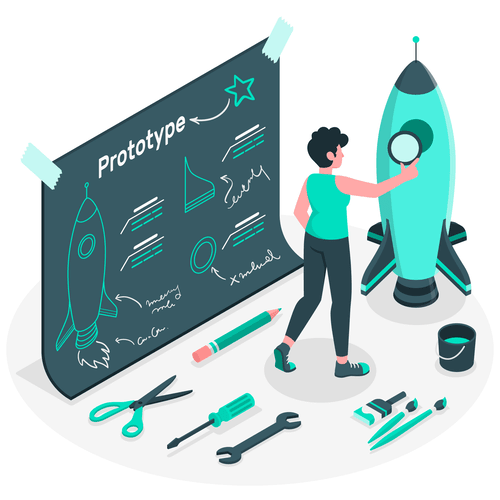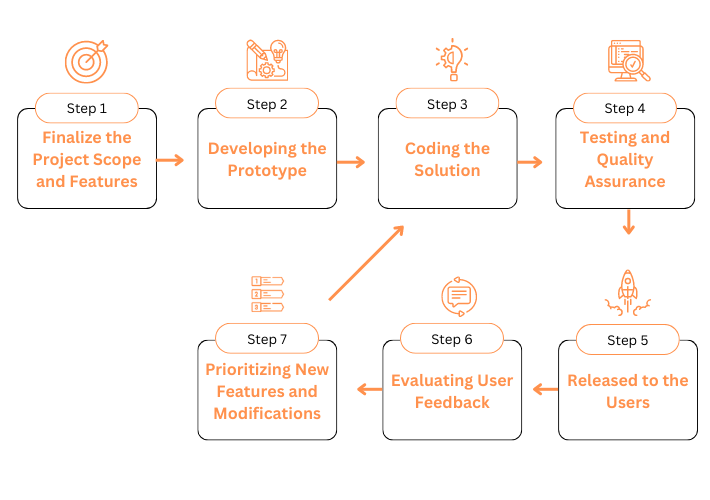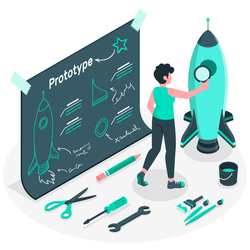
“How much does it cost to build an MVP?”, if this question has been bugging you lately, then you’ve reached your final stop. In this blog, we have discussed the primary cost drivers that affect the final price of an MVP. Read along to know more!
Evaluating the “how much does it cost to build an MVP” question and developing a solution based on the results allows you to test the viability of your idea in the market without over-committing your business resources. Think about it this way - when you want to check the temperature of a swimming pool, do you dip your toe or just dive right in and leave it all to fate? MVPs are like dipping your toe into the market, less risk but enough insights to take a call on its potential !
With over a decade of experience in the custom software development industry, we understand that every solution is unique. Which means taking a generalized quote as a reference point will serve you no good. Some service providers love to throw random estimates in your direction even before you share the high level details of your project. On the flipside, the experts will always prioritize understanding your project requirements in detail before talking numbers (that’s our approach, too)
However, before we start evaluating your ideas, it’s best that you get a firm grip on your project scope and the associated costs, let’s start from the beginning!
Build Your MVP with BinaryFolks
What is an MVP?
Disclaimer : it’s not about the next big shot at the Superbowl next year! Back to the point now. A minimum viable product (MVP) is a software development method where the product is launched into the market with the core functionalities and just the ‘must-have’ features. Along with these essential features, a feedback system is established to take the opinion of the early users into consideration while adding new features and upgrading the overall product.
Now that we are clear about the concept of what an MVP actually is, it’s time to start brainstorming over the more important questions. Once we discuss those points, we are certain that you will have a solid ground for understanding the costs involved with MVP app development. Details ahead!

Is an MVP Better for Your Business Development Objectives Compared to a Complete Solution?
If you care about your money and want to fully commit to your application development only after you’ve seen the initial market response, then yes. Developing an MVP before going all-in for your software development project is a low-risk investment approach. It’s not just about saving some extra bucks, there are additional advantages to choosing the MVP route. Let’s discuss them quickly -

1. Reduces Business Risk
It is obvious that the level of commitment required to develop an MVP will be significantly less than that of developing a fully-fledged application. This saves both the time and resources of your company.

2. You Enter the Market Quickly
Imagine you’re competing with a bunch of companies to introduce a new product into the market. Instead of decorating your product in its most in-demand hours, strike the iron when it’s hot. Call it the early bird benefits or the first mover’s advantage - the bang for the buck is real.
.png)
3. Get the Customer’s Feedback During Development
Post-MVP phase is the perfect time to listen to the user’s opinion on how they feel about the product. As the product lacks the core functionality pre-MVP stage which would inevitably confuse the users. And it is too late to make any changes once the final product is completed.
.png)
4. Is Cost Effective
Last but definitely not least, MVP app development wouldn’t cost an arm and a leg to your business. It is a safer approach towards spending your business’ resources. The thrill of taking risks can wait till your next Vegas trip. (;

Wouldn’t a Prototype or a PoC be Just as Effective?
Now it’s reasonable to think that, “if we are being cautious about how we spend our resources wouldn’t it be “wise” to just use a proof of concept (PoC) or a prototype model to complete the initial analysis and viability of the product?”. Well, here’s the thing…

(a) Proof of Concept
A PoC defines the necessary concepts and technologies to get the investors’ attention by clearing out the “can this idea work?” concerns. However, it does not have enough functionality to be launched in front of its intended audience.

(b) Prototype
These take things a step further, with a prototype, you’ve got a working model to showcase in front of your users. It contains the primary user flows which provide the users with an initial feel for the product/software being developed. However, it is more or less just a UI model without any practical implementation.

(c) Minimum Viable Product
This is the first fully operational iteration of the product since the start of the project cycle. It has the complete operational flow and the core functionalities that the product will be based around. Additionally, the fact that it is not a final product works in your favor. As you get to capitalize on your users’ feedback and develop a solution accordingly.
So it seems that although a PoC and a prototype can be less draining demonstrations financially when compared to an MVP development process. But when it comes to getting the benefit of user feedback to further refine your product, an MVP will be the baseline for you to get the appropriate data for your analysis.
Discuss Your MVP Project Today!
.png)
What are the Factors that Affect the Cost of an MVP?
Okay, now that we know how important MVPs are for analyzing the viability of a product in a practical setup, it’s time to address the elephant in the room - “How much does it cost to build an MVP?”. Well in most cases a service provider will give you an extremely vague estimate, even without understanding what your exact requirements are. That’s not how we roll!
Our consultants discuss your requirements first to understand your high & low-level requirements in detail before presenting a quote in front of you. This allows us to stick to our figures more firmly and provide you with a seamless development experience with minimal hiccups. Here’s a list of parameters we pay special attention to the -

(a) Complexity of the Project
The scope and complexity of an MVP is the primary factor that decides its development cost, as factors like the number of features, the layers in the application, and the overall functionality significantly impact the time and effort required during the development process. Typically the complexity of the MVPs is classified into three categories, much like the classification of the final product itself. Let’s discuss them briefly -
- Simple MVPs: These models typically work around extremely straightforward functionalities, with a handful of features, and a minimalistic UI. The MVP development cost in this scenario is the cheapest, with some common examples being - task management tools, calculators, or weather apps.
- Intermediate MVPs: These solutions have a relatively complex architecture compared to the previously discussed MVP. These intermediate models have a high number of functionalities with the involvement of some external APIs as well, stacking up the complexity levels. Examples include - social media platforms, ecommerce platforms with external payment APIs, team collaboration tools, etc.
- Advanced MVPs: These products are built around complicated use cases that require sophisticated functionality along with advanced decision-making capabilities. Meaning they take a higher level of time and effort to be developed. Advanced MVPs include products that require real-time analysis that update the users almost instantaneously about a certain situation. For example - ride-booking apps, last-minute delivery applications, or enterprise applications.

(b) Cross-Platform Compatibility
The trick while dealing with the compatibility factor across different platforms is to strike a balance between the performance and cost-effectiveness of the project. There are a couple of ways in which the application design affects the MVP development cost -
- Hybrid Applications: If you’re on a limited budget and you cannot afford to develop MVPs optimized for every single platform separately, then the hybrid approach is going to be your savior. However, you need to keep in mind that you cannot include platform-specific features and functionalities in this application format, meaning, it will follow a general user interface. Which might not be that appealing to some users.
- Native Applications: These applications are individually built for every single platform that your product will be used on. Meaning developers can add platform-specific features to these solutions and make the user experience extra engaging. However, these applications need separate code bases which means a single MVP might not be enough for these applications. And more MVPs obviously mean more bucks.
The bottom line remains that, if you have the budget, or, if you are planning to target users from a specific platform, you should go for native application-based MVPs. Alternatively, if your products need to cater to users from all the platforms but you don't have the funding to make optimized solutions for each platform, then, hybrid applications-focused MVPs should be a no-brainer.
.png)
(c) Payment Method
The agreed mode of payment has a significant impact on the overall cost of the MVP development process as well. There are two primary modes of payment, let’s discuss them one by one to get a broader perspective on the concept -
-
Hourly Payments: In this method, the service providers are paid in accordance with the number of hours they spend developing your project every day/week. A major flaw in this approach is the fact that for a business with a non-technical background, it will be really difficult to understand whether the time required to finish a certain milestone is justified or not. The development team can easily come up with an excuse to justify the inflated hours on a specific task and there wouldn’t be any cross argument from the client’s side.
-
Fixed Pricing: In-case of the fixed price model, the cost of the entire project is predetermined after a thorough discussion of the complete project scope. So the risk of inflated hours and slacking during work gets eliminated. In fact, it works to the client's advantage, as the service providers are receiving the same amount no matter how long they spend on the project, they would be determined to finish the project as efficiently as possible to maximize their profits.

(d) Location of Service Providers
When you are outsourcing a team of developers it is very important to keep in mind which part of the world they belong to, because this will reflect in the quality of the overall MVP development process. Confused about how’s that gonna work out? Let’s discuss this concept in a jiffy. There are mainly two classifications of service providers based on their geographic location -
-
Onshore Service Providers: these service providers belong to the same country as yours, meaning they share the same time zone & geographic area. However, since they belong to the same country and are experts in their respective development skills, it is quite expected of them to charge exceptionally high amounts for their services.
-
Offshore Service Providers: typically belong to a part of the world with highly qualified developers but with lower labor costs, making it a perfect hub for your software development needs. The time zones may vary, but offshore developers have adapted to this work culture and are promptly available during the client’s working hours.
“But what was all that discussion about the quality of the final product?”. Think of it this way - consider that you hired two service providers one from your country and another from an offshore country with lower labor costs. Now you paid both of them the same amount of money for developing identical projects. The offshore service provider will automatically prioritize your project more than your onshore service provider, as it is a high-value project from their perspective. This means, even though you are paying the same amount to both parties you will receive a significantly better quality of service from the offshore service providers.
What are Your Service Provider Options for Developing an MVP?
The MVP cost widely varies depending on the type of service provider you choose for the development of your solution. Every option has its own set of advantages and issues, which need to be properly analyzed before locking on to a specific choice. Here are the top 4 options that businesses consider while picking their service provider -
(1) Freelancers
Although it may seem to be a cheaper alternative to hire freelancers, it comes with a number of follow-up arrangements which ultimately takes the development cost back to square one. First, freelancers work as an individual and are typically hired to develop simple applications or a specific part of an enterprise application, meaning collaboration isn’t going to be their forte. So, if your plan is to hire a bunch of freelancers and get them to work together for developing your enterprise-level MVP, then you have to either hire a project manager or become one yourself to get the development process in order.
Another issue with hiring freelancers would be the fact that they do not carry the same level of obligation compared to a firm providing you with the same service. So if things go south with the project, you may see some of your freelancers Houdini their way out into thin air!
(2) Build an In-House Team
Another popular idea is to hire an in-house team for the development of your MVP. Initially, it makes sense as well, considering the MVP development process is not the end of the software development life cycle(SDLC). And it will be good to have a team ready to work on the project as soon as the MVP is approved for further development. But when you start to break things down, you quickly realize how much it’s gonna cost your business. Let’s look at the primary cost drivers linked to hiring an in-house team -
- Recruitment Process: Hiring a new team can be an expensive process; broadcasting, interview, evaluation and training, your company will have to spend a significant amount of resources even before the team starts developing the solution.
- Expenses During the Initial Setup: Since the developers are hired as your full-time employees, you have to pay for the assets, accommodation(if required) and other additional expenses.
- Post-Development Commitment: You cannot just fire your employees after the project development is over, right? And keeping a fully functional team just for occasional maintenance and updates doesn’t sound very pocket friendly.
(3) Hire Local Team
In case you have been to listing websites like Clutch or GoodFirms you would know how expensive it can be to hire local experts. Companies charge as high as $200 for just an hour of their service, calculate it and it’s close to $48,000 a month. And yes, don’t forget, if your software requirement has a complicated architecture it can take several months easily to get the application up and running. Answer the - “How much does it cost to build an MVP?” question here at your own risk.
If you did the math you certainly realize that it’s a lot of dollars. Even though you will receive a high-quality product according to your requirements, it would be alot better if it didn’t rip a hole through your pocket, right? Well, there is a way to get just that! (A high-quality software developed by experts at a fraction of the price)
(4) Outsourcing a Team
An outsourced team is just like hiring a local team but better! To start things off it costs less to outsource your project from a country with a favorable currency pair to yours, compared to hiring a local team for the project. You also get the same level of expertise as these development teams as they have spent an extensive amount of time working in the same field. However, some might argue that outsourcing comes with a fair share of risks that can disrupt the MVP development process.
Lack of trust and collaboration issues are the primary points of discussion in this field. However, in the modern world, these issues can be easily alleviated by harnessing the right technologies and tools. Here’s how -
- Lack of Trust: “What if they took my money and never delivered the product?”. This is a valid concern when you know the developers belong to a different part of the world. But the solution is super simple: set up something called an escrow method of payment which divides the project into smaller parts, and the money is kept with a secured third party. The flow of money is controlled by the third party based on the progress of the project.
- Collaboration Issues: “What if I wanted to clarify an urgent issue and they took weeks to get back to me?”. Again, this would have been a valid concern if it wasn’t for the collaborative tools and arrangements widely used by the outsourcing companies. Forget weeks, the right outsourcing partners will give you a response within hours(if not minutes).

MVP Development Process
The development of an MVP is identical to the development of any other software solution, the only difference is the fact that an MVP is not a finished product. It is the first operational stage that can be introduced in front of a user base. So, after the MVP is developed there is still a large chunk of development that is necessary before the development process can officially be over. The diagram below will help you understand the process more effectively.

Hire Experts to Build Your Solution!
Post Deployment Costs for the MVP
So your MVP is developed & deployed to its intended user base and everything is working seamlessly? Good! But this is not the point where you sit back and relax, there are a few post development actions that your business can take to positively impact the success of your minimum viable product app. Obviously these actions will cost you extra bucks, but the return on investment will make the efforts worthwhile. Here’s a discussion for some of the post MVP development activities -
.png)
1. Marketing & Promotion
Have you ever noticed how tech companies tease their upcoming products months before they are released? In several cases this starts right after the proof of concept is approved, businesses do this to build anticipation among the users and to analyze the market's initial opinion. But for now, let’s just plan the marketing and promotion after the MVP development is over. Because, let’s be honest, if your company isn’t a household name like Apple & Tesla, it’s better to have a product ready for the users so that they can try it out right then and there.
The best way to let the intended users know about your product without skyrocketing the expenses post the MVP app development boils down to two methods -
- Inbound Marketing: The idea here is to produce relevant and informative content wrapped around the MVP in order to attract the right users. It is a highly dependable process as the people approaching via this route are mostly interested in the product you are offering.
- Outbound Marketing: This is a different approach from the one previously discussed. Here you actively reach out to the people who can be a potential customer for your product. The conversion rates in this case is lower as you cannot be sure about whether the users are looking for a product to begin with or not. However, the outreach in this method is significantly higher. PS: you have to be conscious while using this method because it is very easy to overcommit in the wrong direction here.
.png)
2. Maintenance
One of the biggest mistakes businesses make post the MVP development process is to ignore the maintenance and improvement opportunities of the product. It is important to keep your application flawless & up-to-date in order to attract new users and retain the existing ones. It is hard to predict the exact cost of maintaining an MVP as it depends on several factors including - complexity, future scalability scope, external integrations and other factors.

3. Further Development
Knowing that MVP is just the first operational model of your entire project, it is important to factor in the follow up expenses on top of the initial MVP development cost. It will be difficult to give users an exact number on how much the development of an MVP will cost when compared to the entire software. However, considering the fact that an MVP has the core functionality and the basic features under control, we can expect the MVP to cost anywhere between 30-40% of the entire project development cost.
Some Success Stories that Started as MVPs
If you’re second guessing the decision of launching an incomplete version of your project to the users because they might not be able to experience the complete potential of the application right off the bat. Then let me tell you, some of the most popular applications you see online started off as MVP, most of them had an entirely different interface compared to where they stand today -

(a) Facebook
The MVP called ‘TheFacebook’ which was launched all the way back in 2004 by Mark Zuckerberg and some of his college buddies was nowhere close to the way it looks today. The initial model had only a small percentage of the features that Facebook has today, and was supposed to serve only to the users with a Harvard University email. But with the rapid growth in the number of organic users the application was quickly accessible to everyone who was interested to sign up. From then Facebook has been constantly optimizing its functionality and features to reach its current position, and they are continuously working towards improving the UI to provide the users with a better experience.

(b) Uber
In 2009, two friends Travis Kalanick and Garrett Camp took their “black car ride” concept and launched an iPhone exclusive MVP application called “UberCab”. Uber is a classic example of a minimum viable product app that gained popularity without any fancy features, all it did was take a genuine issue and built a viable solution for it. It initially had just the core features of establishing a line of contact between the cab driver and the customer, along with a credit card based payment method. It quickly became popular with the number of downloads reaching new heights everyday, this allowed them to take their services which were initially available only in San Francisco to a global scale.

(c) Twitter
In 2006, the board members of Odeo along with Jack Dorsey decided to launch an MVP that allowed an individual to communicate to a small group of people via an SMS service. For the first 6 months, the application was named as ‘twttr.com' due to several reasons, which they later changed to ‘twitter.com’. The MVP development process was initially focused on serving the users within Odeo but was quickly made available to users outside the company. What started from the first official tweet that was published on the application by Dorsey himself, saying - "just setting up my twttr", has now reached an average of 450 million active monthly users.
.png)
(d) Instagram
Instagram is the perfect example of an MVP model that found its way to success by prioritizing the user needs. The initial MVP that was launched in 2010 known as “Burbn” was an application that allowed users to check into places kinda like what Foursquare was already offering back then. Initially, Burbn struggled to gain the interest of the masses because some of their features were “too complicated” for the user base, however, their image sharing option was an absolute hit. So, the founders decided to focus on that single feature and dropped down all the other complicated functionalities. They even renamed the application to “Instagram”, and the rest is history. Instagram now has approximately 1.2 billion active users all over the world!
Start Your Dream Project Here!
What Makes BinaryFolks Your Perfect MVP Connoisseur?
With the above discussions we were hopefully able to highlight all the factors that we should consider while calculating the MVP development cost for your project. But wait, there’s more! Check out some of our services that will help you solidify your vision into an fully operational model -
(1) We Provide a Well Evaluated Quote for Your Project
Instead of tricking our clients into signing an agreement with a hidden clause that inflates the MVP development cost by a large amount, we prefer to take a more direct approach. Our business analysts and consultants discuss the core functionality and necessary features in detail. And evaluate the requirements based on the latest industry trends to provide you the exact cost of developing the MVP along with the complete project. Once agreed upon, this quote remains fixed for the entire project cycle.
(2) Get a Complimentary Consultation Session for Discussing your MVP Development Process
We provide complimentary consultation sessions for the entrepreneurs that need an MVP solution for their business but need some additional support in framing their requirements due to their exposure to the latest market trends. Our custom software consultants help you out with that, with over 70+ projects and over a decade of experience in the industry, our experts have all the essential tools to give you the best advice when it comes to strategically picking the best-fitting features and architectural layout for your MVP.
(3) Our Developers Help you to Flag The Unnecessary Features that Might be Increasing Your MVP Development Cost
Our consultants make sure that you use your budget optimally for the development of a project. From our experience of developing diverse software pieces over a decade, we understand the difference between “must have” and “good to have” features, which is exactly what our consultants help you with, to set the MVP scope just right.
Conclusion
So, we covered the why’s & what's linked to the question “how much does it cost to build an MVP?”. We also discussed how some companies were able to create a global presence starting off with a humble MVP just like the one you are looking to build right now. We also briefly covered the factors that make BinaryFolks a highly eligible partner for your software development venture. The only thing that remains is you taking the first step towards developing the MVP that will take your business to the next level! Are you in?
Get Complimentary MVP Consultancy
FAQs
The time required for developing an MVP depends on its complexity and list of features included. Typically the time for developing a standard MVP can range anywhere between 1-4 months. The simpler the architecture the less time it will take.
Also Read:How to Estimate Software Development Time?The MVP development benefits your business in 3 primary ways, a lot of which can be explained by discussing the elements of abbreviation individually -
- 1. Minimum - the solution is launched to the user base by spending the minimum amount of resources that are necessary.
- 2. Viable - the MVP has its core functionality completely operational allowing the solution to fulfill the primary issue that the product was built for.
- 3. Product: although with limited features and customization, the product launched should be a complete product without any major bugs or other issues.
MVPs are divided into two categories based on the level of detail and the polishing of the MVPs before they are deployed in the market, they are - -
- 1. Low Fidelity MVPs: these MVPs focus only on the core features and functionalities without being bothered about resembling the final product.
- 2. High Fidelity MVPs: these MVPs focus on representing the final product as much as possible by including advanced features and necessary visual adjustments.
A SaaS MVP can be developed following the steps below -
- 1. Identify the Pain Point you are Planning to Solve with the Solution
- 2. Define the project scope and list the core features
- 3. Design a Roadmap for the Project
- 4. Start the Development Process
- 5. Quality Assurance and Testing Phase
- 6. Receive User Feedback and Improve the SaaS
Yes, in fact it is a good way to test the validity of the product in a real world scenario, business can generate additional revenue from selling these models and also improve the model by leveraging the feedback the customer’s provide after using the solution.

.png)




